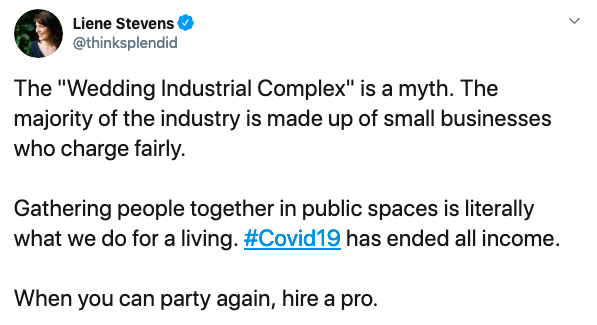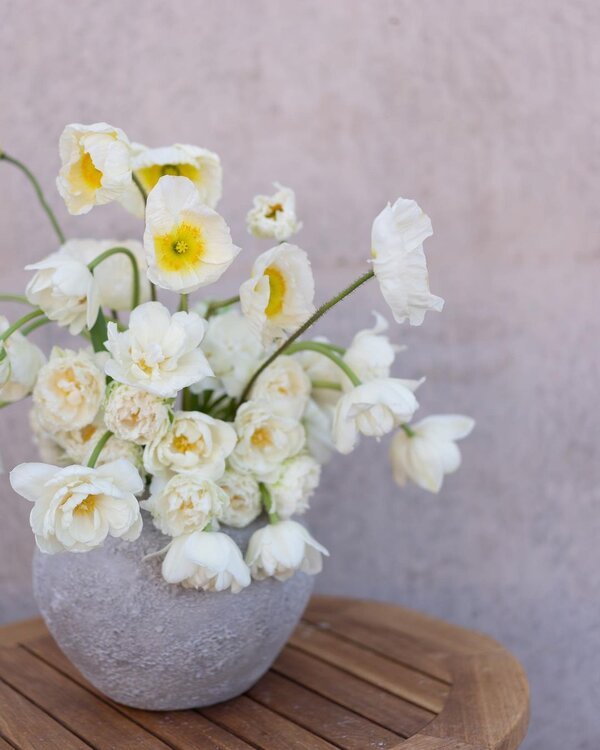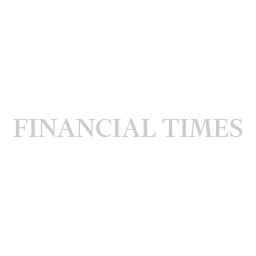The return of the “In this economy?!” argument.
A Splendid Note from Liene:
I’ve been fortunate to have worked with wedding pros from 94 countries over my career and I’ve heard from a ton of them this past month – all with similar questions, stories of lost business, uncertainties of what to say to clients who are completely stressed.
We’re all in this together. If you have questions on Coronavirus and your wedding business, feel free to email me at hello@thinksplendid.com.
I’ll be sharing my answers here on the Think Splendid blog so that everyone can benefit. I’ll also keep your name anonymous. Totally free, no strings attached – I truly do not care if you never hire me.
Focus on the Splendid
We're an industry that makes our living by celebrating life's milestones, so I'm going to start each of these update posts with a few positive COVID-19 things we can all smile about:
TOTAL GLOBAL RECOVERIES
The number of global recoveries is now more than 270,000 people, up from 212,000 on Friday.
A Haute Couture Designer Creates Hospital Gowns
From Malay Mail: “Malaysian fashion designer Khoon Hooi and his team of expert drafters, cutters and seamstresses in Kuala Lumpur have been working hard to manufacture 3,000 hospital gowns to help ease Personal Protective Equipment (PPE) shortages currently faced by Covid-19 frontliners.
Khoon Hooi’s tailors, who are accustomed to sewing couture creations and elegant cheongsams for his eponymous label, are now using their skills to make around 50 PPE medical gowns a day.
This question is from a luxury floral designer:
I’ve been reading all your posts and wanted to get your take on my situation. Last week I received an inquiry from a new client for 2021. I was relieved to be getting a new inquiry as I’ve had two different clients recently cancel altogether even though I encouraged them to postpone.
I sent a proposal and the groom replied that they were expecting a discount since Coronavirus has impacted the economy. I don’t know what to do. I feel I should charge my normal rate because it is a popular Saturday but I am stressed about money. What if I say no and then don’t end up booking that date?
What do you think?
Answer from Liene:
As an industry we get smeared with the big, bad “wedding industrial complex” narrative all the time.
Couples are advised to say the cake is for a party not a wedding or they’ll be charged four times as much.
A bouquet of flowers is $25 at the grocery store but $250 for a wedding, so the greedy florist must be raking in $225 of pure profit.
Engaged couples were already primed to be suspicious that wedding companies were ripping them off long before this pandemic came along.
A lot of couples are asking for discounts right now not only because they do actually now need them, but also because they believe wedding professionals can afford to give them.
After all, weddings are expensive, so everyone in the wedding industry is obviously super rich, each of us quarantining on our own private yachts.
When it comes to whether or not you should lower your prices right now, there are two prevailing schools of thought:
Absolutely not! You’ve spent years building your brand and your expertise and creativity has intrinsic value. Never settle for anything less than your worth!
Yes, of course! Lower your prices and make it up in volume. Grab those bootstraps and let’s go!
Both of these arguments make valid points.
It is true that you don’t want to hurt your long-term business by handling discounts incorrectly and diluting your value.
It is also true that cash is cash and in order to still be in business in 20 years, you have to survive this.
There are no easy answers or silver bullet solutions here, but there are active steps we can take to make sure we set ourselves up for success as best we can.
UNDERSTANDING V-SHAPE RECOVERIES
If you are refusing to lower your prices because you’re counting on a V-shaped recovery in which the economy takes off again just as quickly as it dropped, it’s important to step back and take a look at how they actually work.
V-shape recoveries are real and the best approach is to take advantage of them but to NOT count on them.
Here’s why: history shows us that V-shape recoveries are often not one and done – they are part of a longer economic recovery span that has several mini V recoveries within it.
While it is true that in these types of recoveries the economy tanks fast and then goes back up fast, what people miss is that it then tends to go back down even further than it was before, then back up quickly, then back down even further, and so on.
Here’s a chart from A Wealth of Common Sense that illustrates the market’s recovery path during the dotcom bubble burst and September 11th. You’ll notice several mini V-shapes, and you’ll also notice that their upward bounces did not last long:
The specific economic recovery path for this pandemic remains to be seen, but in the US we saw March 2020 hold the highest number of monthly job losses since 2009. Unfortunately, the economists who were hopeful we’d see a quick, permanent bounce up are walking back those predictions (science and medical experts were never on board with those predictions to begin with).
My advice is to use any temporary V bounces in the stock market and any resulting rise in consumer confidence to book as much business as you can during those stretches and then save, save, save. Sock that cash away so you’re better prepared to weather the next drop.
Stay focused on the big picture: use history as a guide and behave as though there will be several mini V recoveries with tougher times in between so that you can be in as best a financial position as possible for the long haul of this. Do not get a false sense of confidence and splurge on a new Goyard bag in a Treat Yo Self spree on the first market bounce back up.
UNDERSTANDING THE IMPACT ON THE LUXURY MARKET
This is going to impact the wedding professionals who work in the luxury market, too. When it comes to high-end clients, people tend to save and pay for their weddings in two main ways: using money from their savings accounts or pulling from their investment accounts.
People relying on their investment portfolios to pay for their weddings are going to be shaken.
An example from the ultra luxury market in 2009: a high-powered corporate attorney bride and her hedge funder fiancé who were planning a $1.2 million wedding ended up having to cut their budget to $600,000. They had been investing money specifically for their dream wedding for eight years, since neither of them had wealthy parents. When the market crashed, it took their investment portfolio down with it.
Money can be an incredibly personal thing, so even if you want to roll your eyes and say, “Oh no, ONLY $600k, poor babies,” cutting their wedding budget in half still had an emotional impact on them and they became much more hesitant to spend.
Your luxury clients may still spend a lot of money, but it may not be the amount they had originally planned. For those who do still spend the same amount, many will not want their event to look like they spent a ton of money. No one is going to want to get dragged or “cancelled” online for having an over-the-top, seemingly out of touch wedding while the rest of society suffers.
CASH IS CASH AND YOU HAVE BILLS TO PAY
Any of my clients will tell you that I normally advise against lowering your prices. While there are times it can be strategic to work for free, I do agree with the argument that your creativity and expertise has intrinsic worth and deserves a price tag that takes all of that into account.
In normal times when it would be uncomfortable to say no to inquiries that aren’t your dream fit, but still financially doable, I would advise you to stick it out, tighten your spending a bit, and wait until the right client comes along. The client who can afford your higher prices will likely have friends who can afford your higher prices, and it’s worth turning down the other inquiries in order to do the type of work you truly love.
It’s important to note that this advice is given in the context of a non-pandemic world and in a best-case scenario.
I think it’s fairly obvious that we are not currently in a best case scenario. We’re NOT in a worst case scenario yet either, and hopefully never will be, but we ARE in a scenario where you need to make tough decisions that you normally might be able to avoid.
When it comes down to it, I am firmly on Team “Feed Your Babies.” Even if you only have fur babies, you need to be able to provide for them.
If you find yourself in dire straits right now, then yes, take the money! Who cares if it’s not exactly the type of event you love to do? Who cares if it’s not exactly your taste or aesthetic?
I have little doubt you would swallow your pride and take a job as a barista if it came down to doing that or not being able to feed your family.
But now that you’re staring down the very real possibility of losing your house, you’re not supposed to take some “non-portfolio worthy” events because . . . why, exactly?
Because you’ll no longer be able to impress the “see and be seen” industry cool kids on Instagram? The cool kids are not the ones writing you checks.
Because some recent MBA grad with no real world business experience is insisting everyone carry on as if everything is perfectly normal? Great, they can personally pay your mortgage until we’re through this.
Because you’ve been sold the lie that you are your brand? You are not and have never been a brand.
In the wedding industry, Instagram is used primarily as a marketing platform. Since many people subscribe to a “fake it ‘til you make it” marketing philosophy, what ends up being shared is largely smoke and mirrors. Many of the people you admire from afar are not doing as great as they’d like you to think.
Maybe the person who was taking that “faux highlight reel” approach is you. Maybe you heard an online mastermind guru tell everyone this was the way to go and you believed them.
You know better now. Forgive yourself for whatever debt you may have gotten yourself into making your Instagram grid look like you were living the dream because you were “so in demand.” You are not going to be able to focus on what you need to do if you keep kicking yourself for past mistakes.
If you have the opportunity to make money right now by taking work that you might normally be able to pass on, take it. You don’t have to post it. Social media likes don’t pay the bills and “pics or it didn’t happen” is a dumb way to run a business.
PROTECTING YOUR BRAND’S VALUE
I believe there is a way to compromise on your pricing right now without doing irreparable damage to your brand.
Before you agree to any discounts or lower your prices, brainstorm all the ways you can add value to the original price without cutting into your hard costs.
Run your numbers so you know the absolute lowest you can go without going into the red for the wedding.
Do not offer this rate up front, but keep it in mind while negotiating so that you don’t end up in a worse position than you already are.
A lot of times people will get desperate and just throw out a number to not lose the sale and ultimately wind up paying to do the wedding rather than getting paid to do it.It’s important to remember that being authentic and transparent doesn’t require you to lay all of your cards face up on the table. I don’t advise getting into the grittier details of your business or personal finances with your clients. That type of oversharing does not build trust, but instead makes them wonder if you’ll even be in business by the time their wedding rolls around.
If you are going to give a lower price, I recommend framing it as, “I know this is a tough time for everyone, myself included, so we’re willing to make a special exception to work with you. We can’t offer this to everyone, and can’t give others this special rate in the future, but these are extraordinary circumstances and we do want to make this work for you.”
This approach is honest without oversharing or placing some sort of codependent onus on the client to save you.Using dynamic pricing works well for certain types of companies like wedding venues but can dilute a luxury brand’s value quickly, especially since you are offering a service where the value is set on what’s in your brain such as your creative design ideas. In the context of normal scenarios, it’s best for these types of companies to avoid it.
In this case however, when your short-term goal is to generate cash in order to stay open, this model can be a useful stop-gap. One option is to consider sticking to your normal prices for prime weekend dates but offering lower prices for a Tuesday or Wednesday wedding.
I know the industry is pushing hard for weekday weddings right now, but they are unlikely to become a thing because they are not actually a good solution for the couple or their guests. If you have a new inquiry who can’t afford your normal rate, but is willing to take a weekday, offering them a different, lower rate may be a good solution for your cash flow.
Again, if you are not a wedding venue, using dynamic pricing when times are normal will dilute your brand’s long-term value fast. These are not normal times. Make it clear this is a special offer because of the extraordinary circumstances we are in.Context matters and context is often lost on social media. No stunting on the ‘gram during this time.
No selfies of yourself with a glass of champagne in First Class. It doesn’t matter if you purchased the seat with credit card points, were upgraded because of miles, or if your previously booked destination wedding client paid for your flight – you cannot post that photo and then agree to a lower price for potential clients.
Posting photos that make you look like you are giving a discount but don’t actually need the money does not make you come across as generous and understanding – it brands you as never worth the higher rate in the first place.Don’t cry on your Stories about how hard all this is. You can be honest and relatable without broadcasting your meltdowns.
Potential clients are relying on you to be a source of rational, level-headed guidance right now. Save your tears for your morning pages journal or reach out to me, but do not give full vent to your business woes on your public, client-facing social media.
MAKING THE SALE
You may have to do a little more legwork than usual to make the sale, since you’ll be competing against more people now, including ones you normally wouldn’t expect.
You’ll be competing with the wedding pros who are also trying to bring in money by taking on events they might normally refer to others.
You’ll be competing with any company that decides they aren’t going to leave money on the table for others (an example of this is the caterers and event design companies who decided to bring on in-house planners in 2008 in order to not lose that extra money to outside planners – a valid move, but one that caught a lot of wedding planners off guard).
You’ll be competing with the wedding professionals who slash their prices to undoable numbers out of desperation.
If you need to adjust your existing sales process, here are a few things to keep in mind:
NEVER, EVER send pricing right away. This is the biggest pricing mistake wedding pros make, and it will be even more detrimental now.
You may be willing to offer special pricing right now, but do not send anything before you are able to gauge the true scope of their situation and what they need done for their wedding.Do NOT send anything that says, “Our pricing starts at.”
Remember that anchoring bias will cement that lowest number in their brain. Guess what won’t stick? Those two little words, “starts at.”
If this phrase is on your website, delete it from there, too. The point of your website isn't to close the sale. The point of your website is to get potential clients to contact you so you can start a conversation.
Don’t shut down those potential conversations before they even get a chance to start because of premature sticker shock.When you reply to an inquiry, do what you can to get them on the phone rather than trying to get to know them or figure out the scope of their wedding entirely over email.
A silver lining of this pandemic is that it is no longer weird to suggest a video call. A reply to a pricing inquiry could be: “Congratulations, Sarah! I’d love to hear more about your wedding plans, let’s hop on Zoom later this afternoon for a quick 15 minute chat – does 4:30 pm work for you?”
The 15 minutes is important here: people don’t want to invest a lot of time into someone they don’t know yet.
15 minutes is non-threatening and most of the time you’ll find the potential clients want to keep chatting once they are on the phone. Plan to stick to the 15 minutes out of respect for their time, but give yourself a buffer in your schedule in case they want to keep talking longer.Since you do creative design work, ask them to bring 3-5 of their most favorite wedding photos they have saved on Instagram to the Zoom call or to send you a link to their Pinterest page beforehand. It does not have to be photos of your work.
Again, the 3-5 number is key to not making them feeling overwhelmed up front before they’ve even decided whether or not they like you.
One reason for doing this is so you can get an idea for yourself of which styles resonate with them most, especially if they do not have the design vocabulary to describe it accurately. “Romantic” or “simple” mean a million different things to a million different people.
Another reason to do this is because it’s an opportunity for you to show your expertise and educate the potential client on the real costs of a wedding in a conversational, non-lecturing manner.
A couple at the beginning of their wedding planning process likely does not know their real wedding budget yet. If they're having a luxury wedding, they may even assume that their budget will be around $50,000-$60,000 (they’ve heard the US national average is around $30k, so they figure doubling that number is a safe bet). So when they find out in your Zoom call that the photo they’ve had saved on Pinterest for months has $30,000 worth of flowers in it alone, it can be quite the sticker shock.
Your job is to guide them through the sticker shock. You can say something like, “You have great taste. I’m never going to copy another designer’s work, but I will collaborate with you to create something gorgeous on a scale that’s more in line with the amount you’re comfortable spending.”
On the other hand, sometimes once a bride or groom is educated on real costs, they adjust their wedding budget to spend more on what they love, finding the money for the flowers and possibly cutting back on the catering or band. It all depends on what each specific client’s priorities are and you will need to show why you are the splurge-worthy vendor.
This may sound like a lot more work and that’s because it is. You are going to have to work smarter and harder right now.
Let your competitors reply to a pricing inquiry with a one-size-fits-all PDF while you connect face to face over Zoom, making the potential client feel seen, valued, and cared for.
Questions from Wedding Pros
Have a question on a sticky client issue, running a wedding company, or an aspect of business you feel you should know by now yet don’t?
Liene is happy to weigh in with her trademark compassionate yet no-nonsense advice.
To submit a question to our Wedding Pro Q+A column, send us an email. We’ll keep you anonymous.
Written by
LIENE STEVENS
Liene Stevens, the founder and CEO of Think Splendid, is an author, speaker, and award-winning business strategist. Armed with $2000, a healthy work ethic, and an undeserved dose of privilege, Liene bootstrapped Think Splendid from a scribble in a notebook to a successful wedding business consulting firm with a client list spanning 94 countries.
























